《生物化学》课程PPT教学课件(留学生)Chapter 28 Vitamins
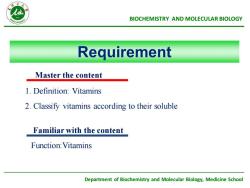
ABIOCHEMISTRYANDMOLECULARBIOLOGYRequirementMasterthecontent1.Definition:Vitamins2.Classify vitamins according totheir solubleFamiliarwith the contentFunction:VitaminsDepartment of Biochemistry and Molecular Biology,Medicine School
Department of Biochemistry and Molecular Biology, Medicine School BIOCHEMISTRY AND MOLECULAR BIOLOGY Requirement Master the content Familiar with the content 1. Definition: Vitamins 2. Classify vitamins according to their soluble. Function:Vitamins
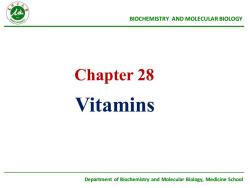
BIOCHEMISTRYANDMOLECULARBIOLOGYChapter 28VitaminsDepartment of Biochemistryand Molecular Biology,MedicineSchool
Department of Biochemistry and Molecular Biology, Medicine School BIOCHEMISTRY AND MOLECULAR BIOLOGY Chapter 28 Vitamins
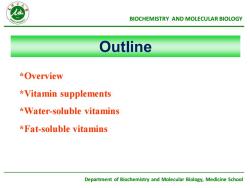
ABIOCHEMISTRYANDMOLECULARBIOLOGYOutline*Overview*Vitamin supplements*Water-soluble vitamins*Fat-soluble vitaminsDepartment of Biochemistryand Molecular Biology,MedicineSchool
Department of Biochemistry and Molecular Biology, Medicine School BIOCHEMISTRY AND MOLECULAR BIOLOGY Outline *Overview *Vitamin supplements *Water-soluble vitamins *Fat-soluble vitamins
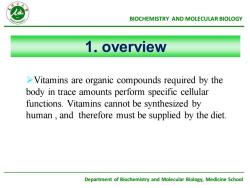
BIOCHEMISTRYANDMOLECULARBIOLOGY1.overview>Vitamins are organic compounds required by thebody in trace amounts perform specific cellularfunctions. Vitamins cannot be synthesized byhuman , and therefore must be supplied by the diet.Department of Biochemistry and Molecular Biology,Medicine School
Department of Biochemistry and Molecular Biology, Medicine School BIOCHEMISTRY AND MOLECULAR BIOLOGY ➢Vitamins are organic compounds required by the body in trace amounts perform specific cellular functions. Vitamins cannot be synthesized by human , and therefore must be supplied by the diet. 1. overview

BIOCHEMISTRYANDMOLECULARBIOLOGY1.overviewWater soluble: B- complexand Vitamin CVitaminsFat-soluble: Vitamin A, D, E, KDepartment of Biochemistry and Molecular Biology,Medicine School
Department of Biochemistry and Molecular Biology, Medicine School BIOCHEMISTRY AND MOLECULAR BIOLOGY Vitamins Water soluble: B- complex and Vitamin C Fat-soluble: Vitamin A, D, E, K 1. overview
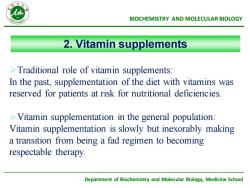
BIOCHEMISTRYANDMOLECULARBIOLOGY2.VitaminsupplementsTraditional role of vitamin supplements:In the past, supplementation of the diet with vitamins wasreserved for patients at risk for nutritional deficiencies>Vitamin supplementation in the general populationVitamin supplementation is slowly but inexorably makingatransition from being a fad regimen to becomingrespectable therapyDepartment of Biochemistry and Molecular Biology,Medicine School
Department of Biochemistry and Molecular Biology, Medicine School BIOCHEMISTRY AND MOLECULAR BIOLOGY 2. Vitamin supplements ➢Traditional role of vitamin supplements: In the past, supplementation of the diet with vitamins was reserved for patients at risk for nutritional deficiencies. ➢Vitamin supplementation in the general population: Vitamin supplementation is slowly but inexorably making a transition from being a fad regimen to becoming respectable therapy
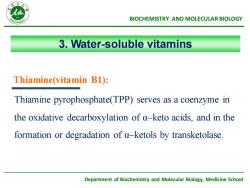
BIOCHEMISTRYANDMOLECULARBIOLOGY3.Water-solublevitaminsThiamine(vitamin Bl):Thiamine pyrophosphate(TPP) serves as a coenzyme inthe oxidative decarboxylation of α-keto acids, and in theformation or degradation of α-ketols by transketolaseDepartment of Biochemistry and Molecular Biology,Medicine School
Department of Biochemistry and Molecular Biology, Medicine School BIOCHEMISTRY AND MOLECULAR BIOLOGY 3. Water-soluble vitamins Thiamine pyrophosphate(TPP) serves as a coenzyme in the oxidative decarboxylation of α–keto acids, and in the formation or degradation of α–ketols by transketolase. Thiamine(vitamin B1):
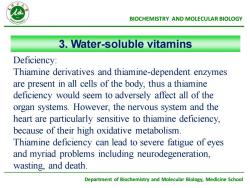
BIOCHEMISTRYANDMOLECULARBIOLOGY3.Water-soluble vitaminsDeficiency:Thiamine derivatives and thiamine-dependent enzymesare present in all cells of the body, thus a thiaminedeficiency would seem to adversely affect all of theorgan systems. However, the nervous system and theheart are particularly sensitive to thiamine deficiency,because of their high oxidative metabolism.Thiamine deficiency can lead to severe fatigue of eyesand myriad problems including neurodegeneration,wasting, and deathDepartment of Biochemistry and Molecular Biology,MedicineSchool
Department of Biochemistry and Molecular Biology, Medicine School BIOCHEMISTRY AND MOLECULAR BIOLOGY 3. Water-soluble vitamins Deficiency: Thiamine derivatives and thiamine-dependent enzymes are present in all cells of the body, thus a thiamine deficiency would seem to adversely affect all of the organ systems. However, the nervous system and the heart are particularly sensitive to thiamine deficiency, because of their high oxidative metabolism. Thiamine deficiency can lead to severe fatigue of eyes and myriad problems including neurodegeneration, wasting, and death
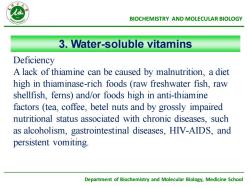
BIOCHEMISTRYANDMOLECULARBIOLOGY3.Water-solublevitaminsDeficiencyA lack of thiamine can be caused by malnutrition, a diethigh in thiaminase-rich foods (raw freshwater fish, rawshellfish,ferns)and/or foodshigh in anti-thiaminefactors (tea, coffee, betel nuts and by grossly impairednutritional status associated with chronic diseases, suchas alcoholism, gastrointestinal diseases, HIV-AIDS, andpersistent vomitingDepartment of Biochemistry and Molecular Biology,Medicine School
Department of Biochemistry and Molecular Biology, Medicine School BIOCHEMISTRY AND MOLECULAR BIOLOGY 3. Water-soluble vitamins Deficiency A lack of thiamine can be caused by malnutrition, a diet high in thiaminase-rich foods (raw freshwater fish, raw shellfish, ferns) and/or foods high in anti-thiamine factors (tea, coffee, betel nuts and by grossly impaired nutritional status associated with chronic diseases, such as alcoholism, gastrointestinal diseases, HIV-AIDS, and persistent vomiting
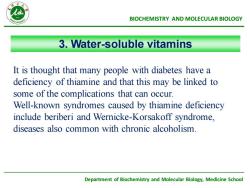
BIOCHEMISTRYANDMOLECULARBIOLOGY3.Water-soluble vitaminsIt is thought that many people with diabetes have adeficiency of thiamine and that this may be linked tosome of the complications that can occur.Well-known syndromes caused by thiamine deficiencyinclude beriberi and Wernicke-Korsakoff syndrome.diseases also common with chronic alcoholismDepartment of Biochemistry and Molecular Biology,Medicine School
Department of Biochemistry and Molecular Biology, Medicine School BIOCHEMISTRY AND MOLECULAR BIOLOGY 3. Water-soluble vitamins It is thought that many people with diabetes have a deficiency of thiamine and that this may be linked to some of the complications that can occur. Well-known syndromes caused by thiamine deficiency include beriberi and Wernicke-Korsakoff syndrome, diseases also common with chronic alcoholism
按次数下载不扣除下载券;
注册用户24小时内重复下载只扣除一次;
顺序:VIP每日次数-->可用次数-->下载券;
- 《生物化学》课程教学资源(文献资料)Lehninger Principles of Biochemistry,5th EDITION,David L. Nelson、Michael M. Cox.pdf
- 《生物化学》课程教学资源(文献资料)临床医本考试大纲.doc
- 《生物化学》课程教学资源(文献资料)临床医本实验大纲 Biochemistry Experiment.doc
- 《生物化学》课程教学资源(文献资料)实验教程.doc
- 《生物化学》课程教学资源(教案讲义)蛋白质的结构与功能.doc
- 《生物化学》课程教学资源(教案讲义)DNA的生物合成.doc
- 《生物化学》课程教学资源(教案讲义)糖代谢.doc
- 《生物化学》课程教学资源(教案讲义)细胞信息转导.doc
- 《生物化学》课程教学资源(文献资料)CURRICULUM FOR UNDER-GRADUATE MEDICAL EDUCATION IN BANGLADESH 2002.pdf
- 《生物化学》课程教学资源(文献资料)Harper’s Illustrated Biochemistry,26th edition,Robert K. Murray Daryl K. Granner Peter A. Mayes Victor W. Rodwell.pdf
- 《生物化学》课程教学资源(文献资料)Syllabus MBBS at the AIIMS(印度).pdf
- 《生物化学》课程教学资源(试卷习题)2012-护理本科-B卷-题目.doc
- 《生物化学》课程教学资源(试卷习题)2012级本科-B卷-题目.doc
- 《生物化学》课程教学资源(试卷习题)2012-护理本科-B卷-答案.doc
- 《生物化学》课程教学资源(试卷习题)2012级本科-B卷-答案.doc
- 《生物化学》课程授课教案(石河子大学:黄瑾).pdf
- 《生物化学》课程教学大纲 Biochemistry(五年制医学专业本科生使用).pdf
- 《病理学》课程教学资源(作业习题)传染病和寄生虫疾病(含答案).pdf
- 重庆医科大学:《病理学》课程教学资源(PPT课件)传染病与寄生虫病(infectious desease and parasitosis).ppt
- 《病理学》课程教学资源(作业习题)神经系统疾病(含答案).pdf
- 《生物化学》课程PPT教学课件(留学生)Chapter 10 Gluconeogenesis.ppt
- 《生物化学》课程PPT教学课件(留学生)Chapter 09 Tricarboxylic Acid Cycle.ppt
- 《生物化学》课程PPT教学课件(留学生)Chapter 33 Molecular Basis of Inherited Disease.ppt
- 《生物化学》课程PPT教学课件(留学生)Chapter 22 Amino acids - metabolism of carbon skeletons.ppt
- 《生物化学》课程PPT教学课件(留学生)Chapter 06 Bioenergetics and Oxidative Phosphorylation.ppt
- 《生物化学》课程PPT教学课件(留学生)Chapter 21 Amino acids - disposal of nitrogen.ppt
- 《生物化学》课程PPT教学课件(留学生)Chapter 07 Introduction of Carbohydrates.ppt
- 《生物化学》课程PPT教学课件(留学生)Chapter 15 glycosaminoglycans.ppt
- 《生物化学》课程PPT教学课件(留学生)Chapter 14 Metabolism of monosaccharides and disaccharides.ppt
- 《生物化学》课程PPT教学课件(留学生)Chapter 01 Amino Acids(structure of amino acid、acid/base properties of amino acid).ppt
- 《生物化学》课程PPT教学课件(留学生)Chapter 01 Amino Acids(overview).ppt
- 《生物化学》课程PPT教学课件(留学生)Chapter 31 Structure and Function of RNA.ppt
- 《生物化学》课程PPT教学课件(留学生)Chapter 20 The metabolism of cholesterol.ppt
- 《生物化学》课程PPT教学课件(留学生)Chapter 29 Metabolism of Nucleotides.ppt
- 《生物化学》课程PPT教学课件(留学生)Chapter 18 phospholipid metabolism.ppt
- 《生物化学》课程PPT教学课件(留学生)Chapter 19 glycolipid metabolism.ppt
- 《生物化学》课程PPT教学课件(留学生)Chapter 32 Biosynthesis of Protein.ppt
- 《生物化学》课程教学资源(PPT课件)18 维生素 Vitamins.ppt
- 《生物化学》课程教学资源(PPT课件)16 血液的生物化学 Hemal Biochemistry.ppt
- 《生物化学》课程教学资源(PPT课件)17 肝的生物化学 Biochemistry in Liver.ppt
